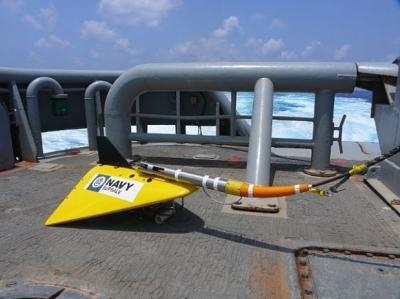Wed, Mar 26, 2014
Towed Array Listening Device Deployed To Search Area In The Indian Ocean
The U.S. Navy is continuing efforts to search for missing Malaysian Airlines flight MH370. As a precautionary measure in case a debris field is located, U.S. Pacific Command ordered U.S. Pacific Fleet to move a black box locator into the region March 24.

If a debris field is confirmed, The Navy's Towed Pinger Locator 25 will add a significant advantage in locating the missing Malaysian aircraft's black box.
The TPL-25 Towed Pinger Locator System is able to locate black boxes on downed Navy and commercial aircraft down to a maximum depth of 20,000 feet anywhere in the world. Commercial aircraft pingers are mounted directly on the flight recorder, the recovery of which is critical to an accident investigation. The Pinger Locator is towed behind a vessel at slow speeds, generally 1-5 knots, depending on the depth. The tow array carries a passive listening device for detecting pingers that automatically transmit an acoustic pulse.
"In the event a debris field is located, we're moving some specialized locator equipment into the area. The Towed Pinger Locator has some highly sensitive listening capability so that if the wreck site is located, we can hear the black box pinger down to a depth of about 20,000 feet. Basically, this super-sensitive hydrophone gets towed behind a commercial vessel very slowly and listens for black box pings," said Cmdr. Chris Budde, U.S. 7th Fleet operations officer.

"This movement is simply a prudent effort to preposition equipment and trained personnel closer to the search area so that if debris is found we will be able to respond as quickly as possible since the battery life of the black box's pinger is limited," said Budde.
If found, the acoustic signal of the pinger is transmitted up the cable and is presented audibly, and can be output to either an oscilloscope or a signal processing computer. The operator monitors the greatest signal strength and records the navigation coordinates. This procedure is repeated on multiple track lines until the final position is triangulated.
The system consists of the tow fish, tow cable, winch, hydraulic power unit, generator, and topside control console.
Most pingers transmit every second at 37.5 kHz, although the TPL can detect any pinger transmitting between 3.5 kHz and 50 kHz at any repetition rate.
(Images provided by the U.S. Navy)
More News
Aero Linx: Model Aeronautical Association of Australia MAAA clubs are about fun flying, camaraderie and community. For over 75 years, the MAAA has been Australia’s largest fl>[...]
Touchdown Zone Lighting Two rows of transverse light bars located symmetrically about the runway centerline normally at 100 foot intervals. The basic system extends 3,000 feet alon>[...]
“Discovery and innovation are central to our mission at Virgin Galactic. We’re excited to build on our successful record of facilitating scientific experiments in subor>[...]
How To Get A Story On Aero-TV News/Feature Programming How do I submit a story idea or lead to Aero-TV? If you would like to submit a story idea or lead, please contact Jim Campbel>[...]
Student Pilot Reported That During Rotation, “All Of A Sudden The Back Of The Plane Kicked To The Right..." Analysis: The student pilot reported that during rotation, “>[...]
 ANN's Daily Aero-Linx (05.02.24)
ANN's Daily Aero-Linx (05.02.24) ANN's Daily Aero-Term (05.02.24): Touchdown Zone Lighting
ANN's Daily Aero-Term (05.02.24): Touchdown Zone Lighting Aero-News: Quote of the Day (05.02.24)
Aero-News: Quote of the Day (05.02.24) ANN FAQ: Contributing To Aero-TV
ANN FAQ: Contributing To Aero-TV NTSB Final Report: Cirrus Design Corp SR20
NTSB Final Report: Cirrus Design Corp SR20




